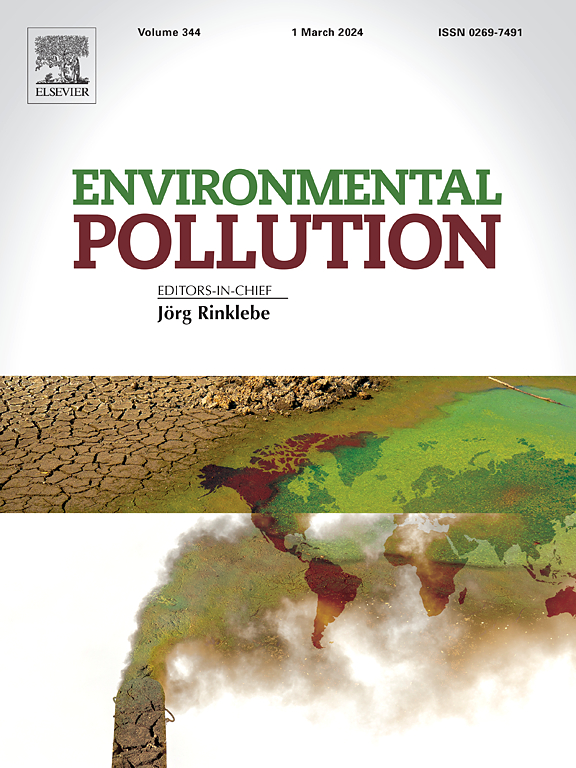Properties of inflowing Pacific and Atlantic water govern total and methylated mercury profiles in the Arctic Ocean
IF 7.6
2区 环境科学与生态学
Q1 ENVIRONMENTAL SCIENCES
引用次数: 0
Abstract
High methylmercury (MeHg) concentrations in Arctic marine biota have been linked to high MeHg uptake driven by shallow MeHg peaks at water depths of 100–300 m in the Arctic Ocean. To understand how the biogeochemical characteristics of each basin affects the distribution of total Hg (THg) and MeHg across the Arctic Ocean, the spatial patterns of THg and MeHg were investigated using data from new transects in the Beaufort Sea (BS) and previously published Arctic Ocean expeditions covering the Canada Basin and Makarov Basin in the Pacific sector, and Amundsen Basin and Nansen Basin in the Atlantic sector. In the BS, the THg concentration in the polar mixed water increased with salinity (r = 0.87, p < 0.01), which was linked to THg transport from the Chukchi Shelf. Transport of Hg from the Chukchi Shelf also drove elevated THg concentrations in the polar mixed water and halocline water in the Canada Basin and Makarov Basin compared to other Arctic basins. The MeHg concentration in the BS was positively correlated with the biological index in the Pacific summer water (r = 0.86, p < 0.01), demonstrating that intrusion of warm and nutrient-rich Pacific water promotes MeHg production in the BS. In line with this result, chlorophyll-a showed a comparable cross-basin trend to that of MeHg, with the highest values in the Nansen Basin. In the halocline water, MeHg concentrations were highest in the Canada Basin likely due to the largest availability of Hg(II). On the contrary, MeHg concentration was highest in the Nansen Basin in the Atlantic water layer, which could be related to the higher seawater temperature and enhanced biological production. The results of this study underscore the critical role of Pacific and Atlantic inflows in modulating the profiles of THg and MeHg in the Arctic Ocean.


流入太平洋和大西洋的水的性质决定了北冰洋中总汞和甲基化汞的分布
北极海洋生物群中的高甲基汞(MeHg)浓度与北冰洋100-300米水深的浅甲基汞峰值驱动的高甲基汞吸收有关。为了了解每个盆地的生物地球化学特征如何影响整个北冰洋的总汞(THg)和总汞(MeHg)的分布,利用波弗特海(BS)的新样带数据和先前发表的北冰洋考察数据,包括太平洋部分的加拿大盆地和马卡罗夫盆地,大西洋部分的阿蒙森盆地和南森盆地,研究了THg和MeHg的空间格局。在BS中,THg浓度随盐度的增加而增加(r = 0.87, p <;0.01),这与楚科奇陆架的THg运输有关。与其他北极盆地相比,楚科奇陆架的汞运输也导致加拿大盆地极地混合水和盐斜水中THg浓度升高。BS中MeHg浓度与太平洋夏季水体生物指数呈正相关(r = 0.86, p <;0.01),表明温暖且营养丰富的太平洋水的入侵促进了BS中MeHg的产生。叶绿素-a与MeHg具有相当的跨流域变化趋势,在南森流域最高。在盐跃层水中,加拿大盆地的甲基汞浓度最高,可能是由于汞(II)的可用性最大。相反,大西洋水层Nansen盆地的MeHg浓度最高,这可能与海水温度升高和生物生产增强有关。本研究的结果强调了太平洋和大西洋流入在调节北冰洋THg和MeHg剖面中的关键作用。
本文章由计算机程序翻译,如有差异,请以英文原文为准。
求助全文
约1分钟内获得全文
求助全文
来源期刊

Environmental Pollution
环境科学-环境科学
CiteScore
16.00
自引率
6.70%
发文量
2082
审稿时长
2.9 months
期刊介绍:
Environmental Pollution is an international peer-reviewed journal that publishes high-quality research papers and review articles covering all aspects of environmental pollution and its impacts on ecosystems and human health.
Subject areas include, but are not limited to:
• Sources and occurrences of pollutants that are clearly defined and measured in environmental compartments, food and food-related items, and human bodies;
• Interlinks between contaminant exposure and biological, ecological, and human health effects, including those of climate change;
• Contaminants of emerging concerns (including but not limited to antibiotic resistant microorganisms or genes, microplastics/nanoplastics, electronic wastes, light, and noise) and/or their biological, ecological, or human health effects;
• Laboratory and field studies on the remediation/mitigation of environmental pollution via new techniques and with clear links to biological, ecological, or human health effects;
• Modeling of pollution processes, patterns, or trends that is of clear environmental and/or human health interest;
• New techniques that measure and examine environmental occurrences, transport, behavior, and effects of pollutants within the environment or the laboratory, provided that they can be clearly used to address problems within regional or global environmental compartments.
 求助内容:
求助内容: 应助结果提醒方式:
应助结果提醒方式:


